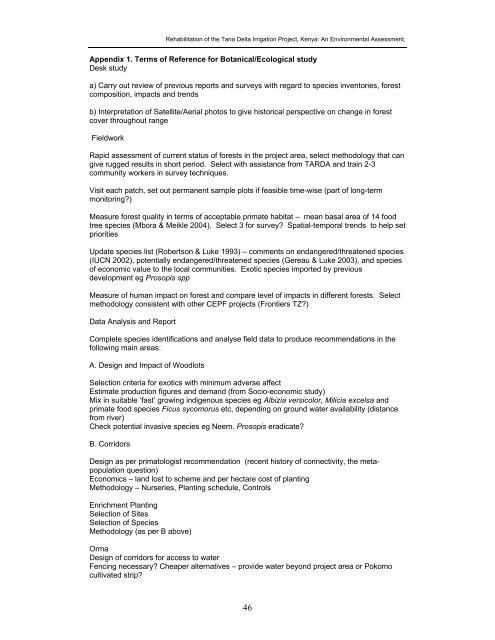Tana Delta Irrigation Project, Kenya: An Environmental Assessment
Tana Delta Irrigation Project, Kenya: An Environmental Assessment
Tana Delta Irrigation Project, Kenya: An Environmental Assessment
Create successful ePaper yourself
Turn your PDF publications into a flip-book with our unique Google optimized e-Paper software.
Rehabilitation of the <strong>Tana</strong> <strong>Delta</strong> <strong>Irrigation</strong> <strong>Project</strong>, <strong>Kenya</strong>: <strong>An</strong> <strong>Environmental</strong> <strong>Assessment</strong>.<br />
Appendix 1. Terms of Reference for Botanical/Ecological study<br />
Desk study<br />
a) Carry out review of previous reports and surveys with regard to species inventories, forest<br />
composition, impacts and trends<br />
b) Interpretation of Satellite/Aerial photos to give historical perspective on change in forest<br />
cover throughout range<br />
Fieldwork<br />
Rapid assessment of current status of forests in the project area, select methodology that can<br />
give rugged results in short period. Select with assistance from TARDA and train 2-3<br />
community workers in survey techniques.<br />
Visit each patch, set out permanent sample plots if feasible time-wise (part of long-term<br />
monitoring?)<br />
Measure forest quality in terms of acceptable primate habitat – mean basal area of 14 food<br />
tree species (Mbora & Meikle 2004). Select 3 for survey? Spatial-temporal trends to help set<br />
priorities<br />
Update species list (Robertson & Luke 1993) – comments on endangered/threatened species<br />
(IUCN 2002), potentially endangered/threatened species (Gereau & Luke 2003), and species<br />
of economic value to the local communities. Exotic species imported by previous<br />
development eg Prosopis spp<br />
Measure of human impact on forest and compare level of impacts in different forests. Select<br />
methodology consistent with other CEPF projects (Frontiers TZ?)<br />
Data <strong>An</strong>alysis and Report<br />
Complete species identifications and analyse field data to produce recommendations in the<br />
following main areas:<br />
A. Design and Impact of Woodlots<br />
Selection criteria for exotics with minimum adverse affect<br />
Estimate production figures and demand (from Socio-economic study)<br />
Mix in suitable ‘fast’ growing indigenous species eg Albizia versicolor, Milicia excelsa and<br />
primate food species Ficus sycomorus etc, depending on ground water availability (distance<br />
from river)<br />
Check potential invasive species eg Neem. Prosopis eradicate?<br />
B. Corridors<br />
Design as per primatologist recommendation (recent history of connectivity, the metapopulation<br />
question)<br />
Economics – land lost to scheme and per hectare cost of planting<br />
Methodology – Nurseries, Planting schedule, Controls<br />
Enrichment Planting<br />
Selection of Sites<br />
Selection of Species<br />
Methodology (as per B above)<br />
Orma<br />
Design of corridors for access to water<br />
Fencing necessary? Cheaper alternatives – provide water beyond project area or Pokomo<br />
cultivated strip?<br />
46

















